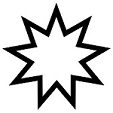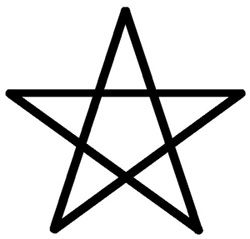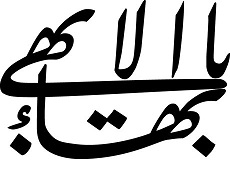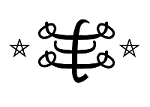Baha’í Symbols Meanings
Baha’í symbols serve to express identification with the Baha’í Faith.
Number Nine
The number nine is one of the Baha’i symbols – It has special significance in the Baha’í Revelation. Being the numerical equivalent of the word ‘Bahá’ (Abjad System) and also the highest single-digit number, it symbolizes completeness, fulfilment, unity and perfection. According to Shoghi Effendi (the Guardian of the Baha’í Faith), it also represents “the nine great world religions of which we have any definite historical knowledge, including the Bábi and Bahá’í Revelations.” Baha’í Houses of Worship have nine sides, and the minimum number of members in a Spiritual Assembly or Universal House of Justice (the administrative bodies elected by Baha’ís around the world) is nine. (http://bahai-library.com/uhj_nine_pointed_star).
The Nine-Pointed Star
The nine-pointed star is among the most commonly used Baha’i symbols. It is an emblem to represent the number nine, but it is not a part of the teachings of the Baha’í Faith. It was developed by Mr. Bourgeois (the architect of the House of Worship in Wilmette, Illinois) and it has been informally adopted by Baha’ís as the preferred symbol of their Faith. “The nine-pointed star (in all its variations) is regarded by many people, both Bahá’í and non-Bahá’í, as a symbol of the Faith, and hence any use of it should be under conditions which are dignified and appropriate.” And, the preferred direction of the central point of the star is upwards. (http://bahai-library.com/uhj_nine_pointed_star).
The Five-Pointed Star
The five-pointed star, or haykal (Arabic: temple) is the official Baha’í Faith symbol as indicated by Shoghi Effendi, “strictly speaking, the five-pointed star is the symbol of our Faith, as used by the Báb and explained by Him.” It represents the human body as a head, two hands, and two feet, but particularly the body of the Manifestation of God and the person of Bahá’u’lláh himself. (http://bahai-library.com/uhj_nine_pointed_star).
The Greatest Name
This Arabic calligraphic rendering of “Yá Bahá’u’l-Abhá” was originally drawn by the early Baha’í calligrapher Mishkín Qalam. This Baha’i symbol represents the Greatest Name. By the Greatest Name it is “meant that Bahá’u’lláh has appeared in God’s Greatest Name, in other words, that He is the supreme Manifestation of God” – The Kitáb-i-Aqdas (The Most Holy Book).
“The Greatest Name is an invocation which means ‘O Thou Glory of Glories!’ The word ‘Bahá’, or ‘Glory’, is a reference to Bahá’u’lláh. The Greatest Name is a distinctive mark of the Cause and a symbol of our Faith.” – From a letter written on behalf of Shoghi Effendi to an individual believer, December 8, 1941.
‘Abdu’l-Bahá explains that the Greatest Name “should be found upon the lips in the first awakening moment of early dawn. It should be fed upon by constant use in daily invocation, in trouble, under opposition, and should be the last word breathed when the head rests upon the pillow at night. It is the name of comfort, protection, happiness, illumination, love and unity.” – ‘Abdu’l-Bahá, Wisdom of the Master, p.58.
The Ringstone Symbol
Designed by `Abdu’l-Bahá (Son of Bahá’u’lláh), the ringstone symbol is another calligraphic representation of the Greatest Name. This Baha’i symbol serves as a visual representation of God’s purpose for humanity. It has:
- two haykals that represent the Báb and Bahá’u’lláh, the twin Manifestations of God for this age
- upper line showing the world of God
- middle line representing the Manifestations of God (Abraham, Krishna, Zoroaster, Moses, Buddha, Jesus, Muhammad, The Báb and Bahá’u’lláh)
- lower line representing humanity and the world of creation
- vertical line that joins the three horizontal lines together representing the link of the Holy Spirit proceeding from God, through the Manifestations, and down to humanity.
The Greatest Name is used with utmost dignity and it is not generally used in a casual manner. “There would, however, be no objection to its use on plaques or ornaments, jewellery or similar items which are not normally put to common use” –From a letter written on behalf of the Universal House of Justice to the National Spiritual Assembly of Belgium, March 12, 1980.
You can read more at:
http://bahaiteachings.org/what-do-the-bahai-symbols-mean
http://bahai-library.com/uhj_nine_pointed_star
Or browse LuminousGEMS jewellery collection.



